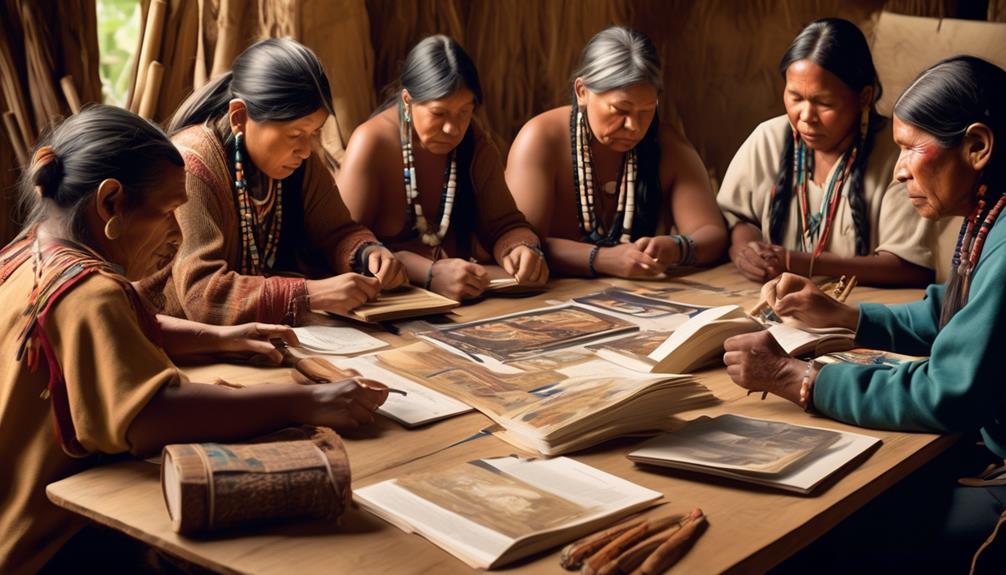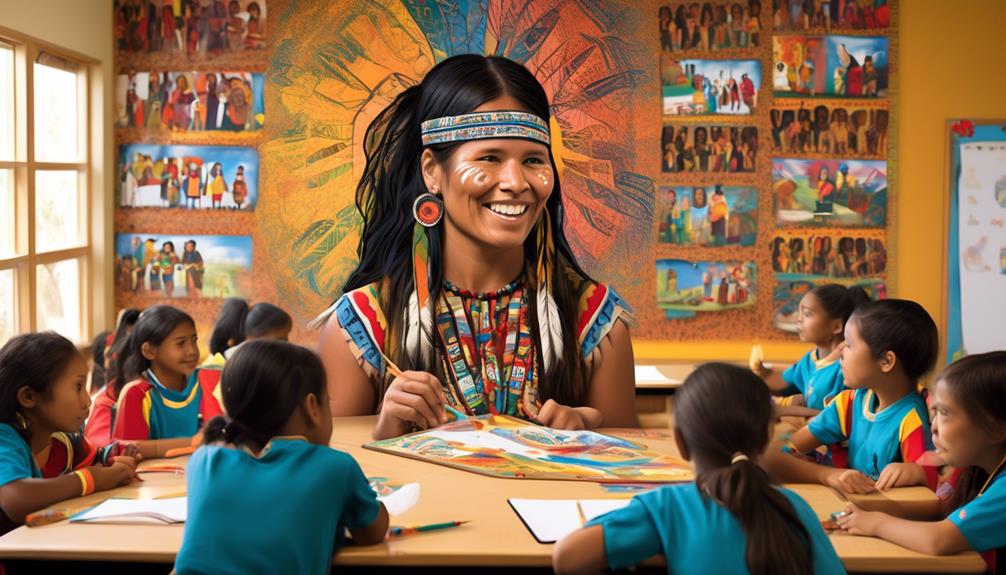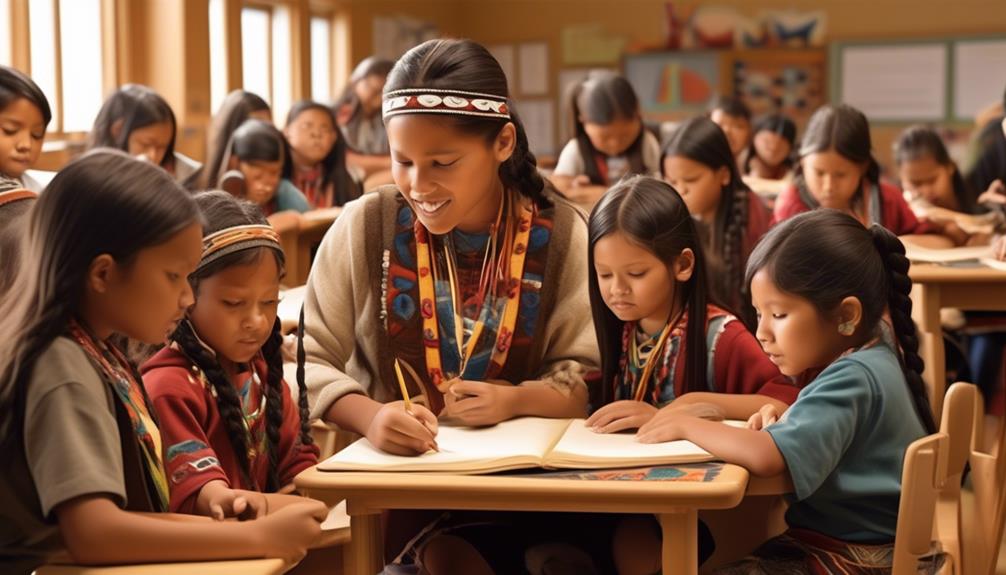We are all aware of the challenges faced by Indigenous Australian communities in preserving their languages; however, there is a quiet revolution happening within these communities that deserves our attention.
Community-led initiatives are proving to be the linchpin in the fight to keep Indigenous Australian languages alive. These grassroots efforts are not only reclaiming and revitalizing languages but also empowering communities to take ownership of their cultural heritage.
The impact of these initiatives reaches far beyond language preservation, fostering a sense of pride, connection, and cultural continuity.
But what exactly are these community-led initiatives, and how are they making such a significant impact?
Key Takeaways
- Community-led initiatives empower Indigenous communities to preserve and revitalize their languages.
- Authenticity and integrity of language preservation efforts are ensured through involvement of language speakers, community members, and Indigenous elders.
- Community-led language programs facilitate a deeper connection to culture and land.
- Collaboration with linguists and educators supports language documentation.
Importance of Indigenous Language Preservation
Preserving Indigenous languages is integral to Australia's cultural heritage and identity, essential for understanding the deep connection between First Nations peoples and the land.
In Australia, the diversity of Indigenous languages reflects the rich tapestry of First Nations communities. Language revitalization isn't just about words; it's about preserving a unique cultural identity. When Indigenous languages thrive, so do the communities and the traditions they represent. This is why language preservation is crucial for the well-being of Indigenous communities. It's a vital part of healing and empowerment, allowing Aboriginal and Torres Strait Islander peoples to reclaim and celebrate their heritage.
Collaborations between Indigenous communities, linguists, and educational institutions are fundamental for language preservation. By working together, we can ensure that the knowledge and practices embedded within these languages are passed down to future generations.
Language loss not only erodes cultural traditions but also impacts the social and emotional well-being of Indigenous communities. Therefore, supporting the preservation of Indigenous languages is a crucial step in honoring and serving these communities.
Challenges in Language Revitalization

The decline of Aboriginal languages, exacerbated by historical policies like forced assimilation, has led to the current challenges in language revitalization. Limited resources and funding pose significant obstacles to language revitalization programs, hindering the efforts to preserve Indigenous Australian languages. Additionally, the lack of fluent speakers and intergenerational transmission further complicates language revival initiatives. Collaboration between Indigenous communities, linguists, and educational institutions is crucial for the successful revitalization of Aboriginal languages.
| Challenges in Language Revitalization | ||
|---|---|---|
| Limited resources and funding | Lack of fluent speakers | Inter generational transmission |
| Historical policies like forced assimilation | Collaboration between Indigenous communities, linguists, and educational institutions |
The preservation of Indigenous Australian languages also depends on the involvement of local communities and the engagement of younger generations. Community-led initiatives play a vital role in language revitalization, as they are often more culturally appropriate and effective in engaging the community. Indigenous Language Centres and other community-based organizations are at the forefront of language preservation efforts, working tirelessly to overcome these challenges and ensure the survival of First Nations languages for generations to come.
Benefits of Community-Led Initiatives
Community-led initiatives empower Indigenous communities to preserve and revitalize their languages, fostering intergenerational transmission and strengthening cultural identity. These initiatives play a pivotal role in promoting the well-being of First Nations peoples by creating inclusive and culturally safe spaces for language learning and revival. By actively involving language speakers, community members, and Indigenous elders, these initiatives ensure the authenticity and integrity of language preservation efforts. Moreover, community-led language programs facilitate a deeper connection to culture and land, enriching the lives of Aboriginal and Torres Strait Islander people.
One of the significant benefits of community-led initiatives is the ability to tailor language revitalization strategies to the specific needs and aspirations of each Indigenous community. This approach ensures that the language preservation efforts are context-specific and culturally relevant, thereby increasing their effectiveness. By fostering intergenerational transmission of language and knowledge, these initiatives contribute to the preservation of unique cultural heritage, strengthening the sense of identity and pride within the language group.
Ultimately, community-led initiatives not only revitalize Indigenous Australian languages but also support the holistic well-being of First Nations peoples.
Key Projects in Language Preservation

After recognizing the benefits of community-led initiatives in preserving Indigenous Australian languages, it's crucial to highlight key projects that actively contribute to language revitalization efforts. These projects play a significant role in ensuring the survival and transmission of Indigenous languages for future generations.
- First Languages Australia: This organization is dedicated to supporting local language projects, providing resources, and fostering collaborations between Indigenous communities, linguists, and educational institutions for the revitalization of Australian Indigenous languages.
- Languages Alive: This initiative focuses on utilizing technology, such as language apps and online resources, to support language learning and preservation. By embracing modern tools, Languages Alive engages younger generations in the learning and usage of their local language.
- Language and Culture Centers: Centers like the Mirima Dawang Woorlab-gerring Language and Culture Centre and the Ngukurr Language Centre are actively involved in language revitalization efforts. They serve as hubs for preserving, documenting, and teaching Indigenous languages while also promoting cultural knowledge and practices within their communities.
These projects not only contribute to language preservation but also play a pivotal role in empowering Indigenous communities to reclaim, celebrate, and pass on their linguistic heritage.
Resources for Language Revival
Utilizing innovative technology and community engagement are vital components in the efforts to revive and preserve Indigenous Australian languages. In the realm of resources for language revival, community-led initiatives play a crucial role. The Aboriginal Language Centre in the Northern Territory, for example, serves as a valuable resource hub, offering language learning materials, documentation support, and cultural programs. Technology, such as language apps and online resources, further supports language revival by providing accessible platforms for learning and practicing Indigenous languages.
Government support and recognition are also essential resources for language revival. They can provide funding for language revitalization programs, which focus on documenting and recording endangered languages. Collaboration between Indigenous communities, linguists, and educational institutions is equally vital for successful language preservation and revival. These partnerships help in developing comprehensive language programs and curricula that integrate Indigenous languages into formal education.
Access to resources is fundamental in empowering Indigenous communities to take ownership of their language preservation efforts. By providing the necessary tools and support, we contribute to the revival and sustainability of Indigenous Australian languages and culture.
Frequently Asked Questions
What Can We Do to Preserve Indigenous Languages?
To preserve indigenous languages, we can organize language workshops, cultural immersion experiences, and storytelling events to promote intergenerational learning.
Additionally, we should support language documentation, digital archives, and language apps.
It's crucial to establish community partnerships, school programs, and linguistic research.
How Are Indigenous Languages Being Revived?
We are reviving indigenous languages through community-led revival efforts, language programs, and cultural immersion. Language champions are promoting intergenerational learning and technology integration.
Linguistic documentation, community engagement, and educational partnerships support these initiatives. Government support is crucial for funding community-controlled Indigenous language centers.
Through these collaborative efforts, we're preserving and revitalizing indigenous languages, promoting cultural pride, and enhancing academic achievement among Aboriginal students.
Why Should We Keep Indigenous Languages Alive?
Preserving Indigenous languages is crucial for maintaining cultural heritage, education, and empowerment.
Reviving Aboriginal languages benefits our community, connecting us to traditional knowledge and fostering resilience.
Through community efforts and language programs, we preserve our identity and promote linguistic diversity.
Keeping Indigenous languages alive is essential for intergenerational transmission and oral storytelling.
It empowers us to communicate our heritage and strengthens our cultural identity.
Why Are Indigenous Languages Important in Australia?
Indigenous languages are crucial in Australia for preserving cultural identity, connection to the land, and passing on traditional knowledge. Revitalizing these languages through community efforts is essential for preserving our heritage and promoting linguistic diversity. It also fosters respect for elders and indigenous knowledge.
However, colonial impact has led to language loss. Government support for language programs is vital for education and preservation.
Conclusion
In conclusion, community-led initiatives are the lifeblood of Indigenous language preservation. They breathe new life into our languages, like a river nourishing the land.
Through these initiatives, we reclaim our heritage, empower our communities, and ensure our languages thrive for generations to come.
It's through our collective efforts that we keep our cultural identity alive and vibrant, like the stars lighting up the night sky.
Together, we'll continue to revitalize and celebrate our Indigenous languages.
Nayeli is our dedicated Editor in Chief, bringing her passion for words and keen editorial eye to every piece of content we produce. With years of experience in the field, she ensures that every article and publication meets the highest standards of quality and clarity. Nayeli’s commitment to storytelling and her deep understanding of our mission make her an invaluable leader in our team.










